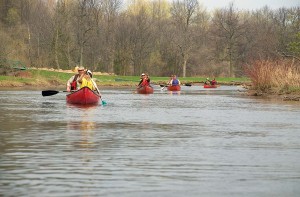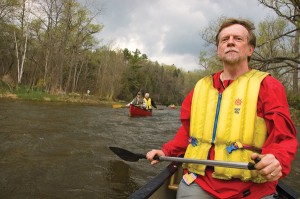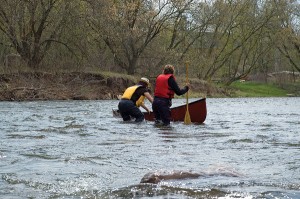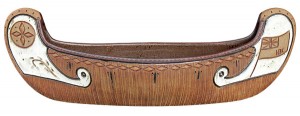Gone Paddling: The Credit River
A group of adventurers challenges the Credit River during spring runoff.
My canoeing partner Geoff Ching and I are poised at the edge of the Credit River. Inches from our feet the water hurtles past with unbridled purpose. It’s early April and the river is running high – higher than we’ve ever seen it.
Shaking off the rust from a long winter I stare into the current and follow its line, slowly dialling in until my focus is clear. In midstream the water drives against a concrete bridge support that knifes the flow into twin sluiceways. We ready the boat, then choose our path. The Credit won’t be tamed until the melting snows have surged into Lake Ontario at Port Credit, 65 river-kilometres to the south.
We’re here to scout the river in Geoff’s new canoe, an Old Town “Discovery,” for a larger flotilla to follow in three weeks time. I’ve naïvely invited several friends for a day on the Credit. I’d expected maybe half to show up, but now I’m scrambling – they’re all coming, and some of them are novices without their own gear! So when Geoff suggests we check out the route beforehand, I nod eagerly. Better to know what we’re up against than to send our crew into uncharted waters.
The air feels damp and our anticipation is palpable. I take the bow seat – the law of the sea decrees that Geoff captain his own ship. Unbeknownst to him, I relish the bow in fast water – it heightens the excitement. There’s no better fun for a canoeist than to run a rapid knowing the slightest miscue could send him ass over tea kettle into the drink for the ride of his life. And should the need arise, the kneeling position lends itself nicely to moments of urgent supplication.
“Hang on!” Geoff shouts over the chaos of water churning against rock. Bracing the canoe, we skid around a tight bend and almost lose it. Geoff catches us by leaning back and executing a broad, arcing sweep behind the stern. For more than three hours we perform our paddling acrobatics through riffles, waves and drops, occasionally bailing, once pulling ashore to dump the water from our boat. The canoe has a low prow and each time we plow through a standing wave we ship copious quantities of frigid water. I’ve worn rain pants in anticipation of the soaking, but instead of keeping the water out, they hold it in. Overall, though, the canoe performs admirably and Geoff is pleased.
Verdant life has yet to unfold; the brittle, brown mat left from the previous autumn reveals no sign of spring. Downstream from Terra Cotta, a deciduous woodland stands bleakly naked. Here, we pull ashore for a snack. Dirty, granular snow blankets much of the landscape and the sedge is dry. A solitary spider stumbles across the expanse of a miniature arctic wasteland.
Back on our way, we flush mallards, mergansers and a pair of common goldeneyes from the reedy shoreline eddies. Canada geese are abundant and, as we approach, their cacophonous din shatters the tranquility. Looking up, we spot a hawk and later a belted kingfisher.
Below the remains of the Barber Paper Mill Dam at Georgetown, we run swifts as they tumble over rock and sediment, the meltwater careens and collides, leaping up in sparkling sprays only to fall and rejoin the flow in its manic quest for open water. Drenched and sporting grins as wide as our faces, we land at the Silver Creek confluence and carry our gear to the parking lot where we’ve left our return vehicle. It was an exhilarating run and back in Geoff’s garage, we celebrate with a beer.
Three weeks later we’re back in Inglewood below the bridge on McLaughlin Road, amazed at how quickly the water has fallen. Since Geoff and I scouted the river, it has dropped 30 centimetres. Where twin torrents had forced us to duck under the bridge, there is now only a single passage along the left bank. Putting our heads together, we make the call: we’ll take out at Glen Williams. Downstream from Georgetown the river will be unnavigable.
Our loosely organized band of canoe enthusiasts calls itself “The Canoeing Legends.” That we are legends is irrefutable: it’s painted on our trailer. For this adventure, we number seven canoes. There is an easy ambience as we mill about preparing the boats for launch. After all, we are kindred spirits. A day earlier, thunderstorms had been forecast and no one backed out. That was a relief because to outfit this crew I’ve had to beg favours from people I don’t even know.
Novice paddlers are paired with veterans. One of the novices, our young photographer, Tom Partlett, sits amidship in my boat. Andrew Hughes settles into the bow seat and we push away, letting the river do the work. Before we have a chance to practise our paddle strokes, we round a bend and immediately become mired in the branches of an immense, overhanging sweeper.
We struggle to disentangle ourselves, but we’re not quick enough. The others round the bend and catch us in our glory. Geoff later jokes that he noticed an expression of grave concern on Tom’s face as our canoe heeled dangerously toward capsizing.
The Credit River meanders south through farmlands and sleepy hamlets from its headwaters in Dufferin County, and is joined en route by its main tributaries: Shaws Creek in Alton, the West Credit River at the Forks of the Credit near Belfountain, and Silver Creek at Norval. Along its 90-kilometre course, the Credit is fed by 1,500 kilometres of creeks and streams, finally flowing into Lake Ontario at a rate of 690,000 cubic metres per day.
On this day, the river carries our flotilla at a leisurely pace, allowing us to hone our paddling skills. For the most part we successfully skirt the sweepers waiting to snatch us from our seats. We scan the route ahead for tell-tale riffles that betray sandstone rocks and pieces of shale lurking beneath the surface. As we pass the Caledon Country Club, some of us run a chute under the bridge, but not before emptying our gear from the boats to increase buoyancy.
Further downstream, another chute cascades past a concrete bridge abutment where a group of fishermen cheers us on. Everyone makes it but Andrew and me – we grind to a halt on the ledge and perch there awkwardly amid the rushing water. The anglers watch with fascination as we carefully step out onto a submerged rock and pull the canoe back from the brink. Instructing Tom to take a hike, we slip through on the second try, then collect Tom back into the boat below the chute.
Our final obstacle is the Haines Dam at Cheltenham, which must be portaged in low water. My wife, Debby, is paddling with Dan Bell who speculates about whether they should try the drop. I crane my neck to see over the precipice and my pulse quickens, but Debby says no. We pull up onto the right bank and lug the canoes to the base of the dam. There, we are shocked to see the river studded with huge boulders that weren’t visible from above. Any one of them would have knocked a canoe off course and dumped its paddlers unceremoniously into the rock garden. Dan turns to Debby and intones, “Good call.”
The slower course of the river affords us glimpses of spring. Bloodroot and trout lilies bloom on the sunlit floors of the still leafless maple forests and trilliums dot the valley sides. Graham Bryan, our man from the Canadian Wildlife Service, cheerfully provides us with astounding observations. Among other things, he points to a mature elm tree in Terra Cotta that escaped the scourge carried by the elm bark beetle in the 1950s and ’60s. Below Terra Cotta we pass alongside the brownish-red layers of Queenston shale that gave the village its name. Further along, Geoff notices a colony of fiddleheads and we fantasize about steaming the coiled young fern fronds with a little salt, butter and lemon.
Glancing ahead, I notice a canoe stuck fast in midstream, the current slicing high over its haunches. This can mean only one thing: it’s hung up on a rock. Smiling, I tap Tom on the shoulder and he promptly slumps against a thwart and coolly begins to shoot what will be an amazing sequence of photographs illustrating a classic case of misadventure by canoe. Probable cause: rubbernecking.
Slowly, the water pivots the boat until it comes broadside to the current. Now the river has it pinned against the rock. Our approach has brought us close enough to identify the occupants: Leslie Schwarzl and Karen McKimmon, two of Debby’s pals from previous canoe trips. They have stopped paddling and are firmly gripping the gunwales. Next, the canoe begins to tip upriver and fill with water. As I watch, it all seems to be happening in slow motion. But the spell is broken when suddenly, in real time, Karen tries to scrabble up the raised side of the hull. Leslie leans away, but it’s too late – they’re past the point of no return. The canoe flips and with a splash they disappear from view. Mercifully they pop up an instant later, grab the overturned canoe, and wade laboriously to shore in the knee-deep water.
Andrew and I had already begun sidling alongside for the rescue operation, but now that simply involves hauling the canoe ashore and dumping out the water. Great sports that they are, Leslie and Karen smile broadly and pose dripping wet for photographs.
Back on course, it’s only minutes before we reach our destination in Glen Williams where we take out and load the canoes onto the return vehicles. The swimmers are almost dry. We hike up the hill to a local pub where, in high spirits, we enjoy a pint and some fish and chips, and entertain ourselves with the pictures stored in Tom’s camera.
After what she calls a “fun, fun day on the Credit,” Karen sheepishly admits that neither she nor Leslie “thought we could actually tip in the Credit … ’til we were in and scrambling to grab the canoe. We ended ‘up the creek’ – well, ‘down the river’ – without a paddle!” She notes that she too experienced the action in “slo-mo” – one of the brain’s survival mechanisms perhaps.
When I return to work the day after the Credit River runs under my belt, I catch myself in a reverie: I hear the sound of the river ahead – the turbulence, the chaos; it won’t be long before the “Gone Canoeing” sign is posted again on my door.
Red Canvas Canoe
An ad in the paper: “For Sale a Canoe,
It’s red and it’s wooden; very well used.
Come by to see it, you may want to call first,
It’s been out in the yard now for better or worse.
Make me an offer and take it away
From Forty-Four Wildflower Lane.”
I went down to the cottage and knocked on the door.
An old woman answered, she was eighty or more.
She said “It’s out by the back fence, I’ll show it to you,
It’s been down the Dumoine and the French River too.
Make me an offer and take it away
From Forty-Four Wildflower Lane.
Harold bought this for me on the day we were wed,
A canoe for a canopy, our wedding bed.
We carried it outside and slept on the lawn
And slapped at mosquitoes until it was dawn
Then we sailed away
All the way to the sea
In this red canvas canoe, Harold and me.
It’s been fourteen years now since Harold is gone.
This cottage is lonesome, I’m moving on.
I’ll give you my paddle and, oh, by the way
We used to float in the moonlight
Out on Georgian Bay
As we sailed away
All the way to the sea
In this red canvas canoe, Harold and me.
And at night when I’m wishing upon a star
And we’d dream of the rivers we travelled afar
In this red canvas canoe, Harold and me.
Make me an offer and take it away
From Forty-Four Wildflower Lane.
Make me an offer, please take this away
From Forty-Four Wildflower Lane.”
Words and music by Mono Centre singer/songwriter Lorraine McDonald, on the compilation CD, Canoe Songs, Volume II, available at www.canoesongs.ca. Partial sales proceeds go to the Canadian Canoe Museum.
… Meanwhile on the Grand
The Credit is just one of four rivers in the Headwaters region, along with the Grand, the Nottawasaga and the Humber. With the Credit under our belts, “The Canoeing Legends” are keen to tackle another one.
Bob Jerome, a former resident of Waldemar on the Grand River, had tantalized us with a scene worthy of Canadian Geographic: during spring breakup the ice floes on the Grand can become wedged under solid sheets, causing them to shift like tectonic plates and heaving up magnificent crystalline sculptures. One year, Bob watched from his window as the village dam burst under the pressure and, unleashed, the icy debris swept downriver. A stake in his property near Bob’s house marked the high-water mark – fully 2o metres beyond the riverbank. Taking into account the incline, Bob figures the river swells to a depth of three metres.
That same year, shortly after breakup, he watched incredulously as five canoes swept past at breakneck speed, the paddlers hollering like cowboys. It was Al Pace and Lin Ward of Canoe North Adventures taking their clients on a “test run” before they whisk them away during the summer to the rivers of the far north. Last spring, photographer Tom Partlett and I were invited to join them in one of these orientation sessions – a combination meet-and-greet and Introduction to Whitewater 1o1.
Based in Hockley Valley, Al and Lin have been operating their canoe-trekking business for eighteen years, offering two-week excursions along wilderness rivers in the Yukon, Northwest Territories and Nunavut. Although he had canoed in the north since he was a youth, the excursion business was a second career for Al, who is now 5o. He studied pottery in the arts program at Lakefield College near Peterborough and, after graduating, quickly established a successful career as a potter. His Farmhouse Pottery studio on Hockley Road now also doubles as headquarters for Canoe North Adventures.
Over the years, the two businesses have coalesced through Al’s art, as he has integrated the textures, forms and iconography of the northern landscape into his wheel-thrown vases, urns and display plates and bowls – including a popular series of canoe-shaped vessels.
Last year, in a career highlight that truly merged his two passions, Al was invited to return to Peterborough to show his work in a solo exhibition called “Legacy Wild” at the Canadian Canoe Museum. The show was officially opened by Prince Andrew, Duke of York. The prince had been a Lakefield schoolmate of Al’s and a companion on some of his northern adventures. He is also the patron of the Canoe Museum.
Unfortunately, on the day Tom and I eagerly met Al and Lin on the banks of the Grand for the test run, we were destined for disappointment. Spring runoff is ephemeral, in the blink of an eye it’s over. The swollen waters of just a week previously were now shallow and tamed. We called off the session, but we knew the “Legends” had discovered another fast-water gem. This spring, when the skis have been put away and the smell of renewed expectation hangs in the air, you’ll find us hustling about on the riverbank, eagerly preparing for our wild ride.
For information about Canoe North, visit www.canoenorthadventures.com.
Canoeing the Credit
Although Credit Valley Conservation “does not endorse navigation of the river,” its website does include tips on navigating the river successfully, as well as some highlights along the route. See www.creditvalleycons.ca. Last spring the Credit Valley Conservation Foundation hosted a canoe excursion along the river in support of the Conservation Youth Corps program. The event attracted 1oo paddlers and raised $26,ooo for reforestation projects.
Before you launch, consider the following advice and cautions from CVC:
- Given its overall high gradient, currents can be dangerous especially during high flows at locations (old dams or log jams) where constricted flow chutes are present.
- At low flows, many boulders and shallow riffles are present (even small kayaks get scraped, bumped and beached).
- Lifejackets are a must, and hypothermia a serious concern in late spring.
- Water quality can be unsafe for body contact (eyes, ears, nose, mouth and cuts), especially following rainfalls (never drink the water).
- Log jams and beaver dams can require portages.
- Some reaches may have fencing or barbed wire stretched across the river.
- Much of the upper reaches are privately owned such that trespassing is a concern (the Ministry of Natural Resources should be consulted).
- Privately owned dams (existing and old) require portages that result in trespass.
- Dogs and even cattle along private property could present a problem.
- Liability and injury concerns re: navigation through various golf courses.
- Watch out for poison ivy and stinging nettle plants along the banks.
- The entire Credit cannot be navigated in one day and there are no camping opportunities along the way, but one is usually within an hour or so from a public road crossing.
- Public phones and general stores are found near the river in Orangeville, Alton, Inglewood, Terra Cotta, Glen Williams, Norval, Huttonville, Meadowvale, Streetsville and Port Credit.
- Topographic maps for navigation purposes are not readily available for the Credit River from CVC, but are available from normal government map outlets. Two National Topographic Series (NTS) maps and about 15 Ontario Base Maps (OBM) cover the river from source to mouth. Even the best ones do not show rapids, old dams or constrictions and log jams.
Related Stories

Canoe North Adventures
Mar 23, 2012 | | LeisureTaylor Pace, Al Pace and Lin Ward of Hockley Valley operate Canoe North Adventures and have led 90 expeditions on 21 rivers in the NWT, Yukon and Nunavut.











Hi Mr. Storr,
Are you related to someone named Al Storr who was a canoeing guide at Keewaydin Temagami in the summer of 1960?
Thanks,
Joseph Burns
Joseph Burns on Mar 22, 2015 at 3:06 pm |